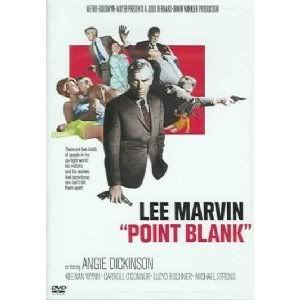"Catching up with a Classic" will be a recurring series here on Setting the Frame, where I screen a classic film that I've never seen and share my thoughts with you. I try to watch as many films as possible, but even some really big films slip through the cracks. If you have any recommendations for this feature, feel free to suggest. If they're on DVD or Blu-Ray, I'll try to track them down.
Point Blank
Dir: John Boorman
Starring: Lee Marvin, Angie Dickinson, Keenan Wynn, John Vernon
My first experience with Richard Stark’s novel, The Hunter, on which Point Blank is based, was the 1999 movie, Payback. My friends and I saw a sneak preview before the opening of the film and absolutely loved it. Payback is a cool, darkly comedic take on the material, and we all had a great time watching the bad guys get it handed to them by [then in his prime] Mel Gibson.
A few years later, Payback Straight Up: The Director’s Cut was released to home video, and we learned that the theatrical version was retooled and much of the added footage was shot without the director, Brian Helgeland. This edition restored the original look of the film, removed some characters and storylines entirely, and was more of a throwback to the gritty action films of the 1970’s. Although drastically different, I still thoroughly enjoyed this alternate version.
It was no surprise then when I also enjoyed Point Blank. Being that familiar with the recent adaptations made me fearful of being jaded towards it, like a reverse effect of my feelings towards Hollywood
The setup is simple. Walker is a small time bruiser who is double crossed, shot, and left for dead by his partner and his cheating wife after a successful robbery on Alcatraz Island
When called for, he uses his brain over his brawn, but there is no question that Walker
Angie Dickinson is Walker
John Vernon, who is best known as Dean Wormer from Animal House, plays Mal Reese, the man who shot Walker Vernon Walker
In a small, but pivotal role, Keenan Wynn plays the mysterious Yost. He keeps a close eye on Walker Walker Walker
There’s a very surreal quality to Point Blank’s early scenes that keeps the audience off balance. The opening sequence, for example, is cut together using a combination of motion picture and still frames, playing with the notion of fractured memories, the type that result from severe trauma. The entire first reel is surprisingly avant-garde for a major studio film of the time, causing the audience to doubt the picture’s reality.
Eventually, the film settles into a more conventional structure and one could certainly enjoy Point Blank for its hard-boiled entertainment value alone. The film is a stylish revenge picture, maybe one of the all-time greats. Walker
The director, John Boorman, made very specific choices and we’re meant to question the meaning of the flashbacks, fantasy, and ambiguous characters. It’s not just style for the sake of style. Did Walker Alcatraz , fighting for his life after Reese shot him, the entire film his dying dream of retribution?
I’m not sure whether I’ll ever be sold on any one explanation, but that’s not the point. The filmmakers respected their audience enough to know that they didn’t need to provide all the answers. “Reality-benders”, like Point Blank, always require your participation and imagination, but rarely offer easy answers. There’s just enough room to doubt yourself even when you think you have it figured out, which is exactly why I will be revisiting this classic again soon.
Until next time...
Until next time...

No comments:
Post a Comment